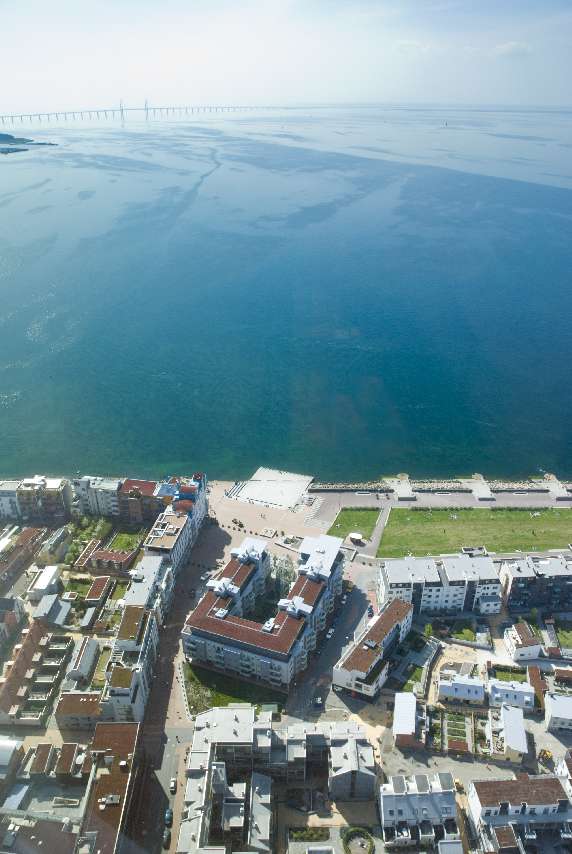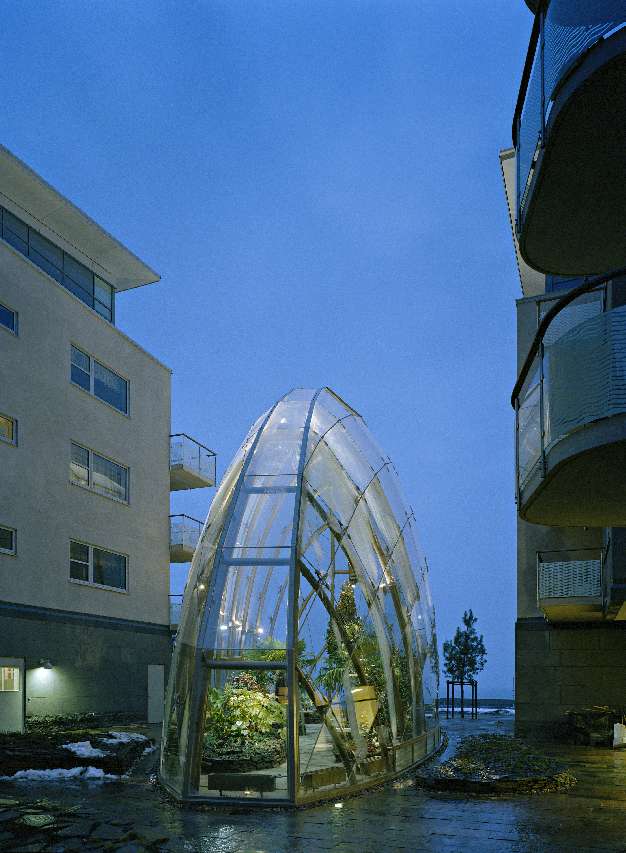Background
It all started with a meeting with the board of Södertorpsgården, an organization that manages buildings providing flats for elderly people in Malmö. They took a vivid interest in their buildings, they improved and extended their premises. Christer, the project manager of the municipal housing corporation, was to oversee the erection of a new building at a prominent, central site by the sea. A decision had been taken about the contractor for the building, and the time had come for the grounds. The board appreciated my previous projects, and now they chose me as landscape architect.
In the local plan for the city of Malmö, the site had been set aside for an exhibition hall. The housing fair five years previously had been a great success with exciting exhibitions and innovative architecture, but the building in question had never been erected. Now the site, on the outskirts of the new state-of-the-art housing estate, was empty. In the local plan the building opened up to the sea and to the prevalent wind direction much like the letter U. The shadow cast by the building would fall on the yard during the major part of the day. It was a difficult point of departure; the site would not allow a traditional garden. But the very difficulty of it was a challenge. Would it be possible to create a garden here – in this narrow, dark and windy yard?
A garden
A garden at an impossible site was a challenge that had excited me once already. In the project “Sheltered Tree” I wanted to plant trees in extremely exposed places and make them survive with the help of conservatories. I was fascinated with the connection: the conservatory serving as an incubator for the tree, the tree and the conservatory being an image of our need to look after living things we choose to have around us and cherish. In the project “Sheltered Tree” a small orange tree was to grow in a field of volcanic stones in Iceland. The work was to be financed by the biggest industry in Iceland, the aluminium smelting plant in Hafnarfjordur. But their managing director asked whether the construction was in any way connected with the environmental effects of the smelting plant. If I had answered, “Of course not, this is a garden,” the glassed-in orange tree would have been there today, under the care of the smelting plant. As it turned out I answered, “This is a work of art. It is in the nature of a work of art to be open to the interpretations of the onlookers,” and they chose to spend the money on a plantation with no conservatory.
More than ten years later I was again face to face with a site with a harsh climate. This time I had a commission. What I had to show was not much of a draft – a piece of clay which I placed in the model of the building together with a couple of quick, hand-drawn sketches. The glass structure was a freestanding, curved form, as big as possible. Its contours were as softly sweeping as those of the Crystal Palace in London in the middle of the 19th century. It was an orangery or a greenhouse in the proper sense of the word: simple, clear glass, perhaps some moisture on the glass from the plants and the soil. A protected garden in an impossible spot, planted on top of an underground garage. They chose the most extreme solution, the one whose size was the most provocative. The project proceeded. I had a clear idea of the glass bubble but it was not easy to find a builder. Christer contacted Happolds in London. We went there – the members of the board, Christer and I – to discuss different construction strategies, and we took the opportunity to visit both old and new glass structures. The contract for the glass job was placed in the same way as my contract, only this time I was on the committee. We singled out the three most interesting firms. Christer and I visited them. Octatube in the Netherlands, which is run by Mick Eekhout, inventor, constructor and architect, was by far the best. Together we continued to develop the construction.
At the second meeting in Delft Mick said, “There are three kinds of project: things we have done before and know we can handle; border-cases – things we have not done before but which can perhaps be done; and, third, things we know we cannot build. Things go wrong only in one type of project”. “Which one,” I asked. “When you work with things you have done previously. You relax, thinking that you are able to do it, and suddenly you make a mistake”. “OK,” I said. “What about the glass bubble? Have you done anything similar before?” “Well, we have built similar structures, not exactly the same but similar ones”.
“So how can we make it more difficult?
How can we change the construction to make it a greater challenge?”
Now all the participants, except for the Christer, the project manager, who had become a bit nervous from this new development, felt elated and alert and started to come up with ideas for simplifications and improvements. The horizontal framework was removed altogether, and all that remained was steel arches anchored in the ground and glass binding the arches together. The glass became supporting like an eggshell. No pains were spared during the planning and design work. Octatube built mock-ups, that is full-scale models, parts of the glasshouse where we compared thermopane against glass, crystal against glass, and tested how the steel structure looked and how the glass-panes were secured. The models were erected in the big hall at Octatube. It all looked enormous indoors. Lena, one of the board members, exclaimed, “Wow! Is it going to be that big!” “No, this is just half the size”, said Mick. When the whole structure was assembled in an open space outside the workshop as a test it suddenly seemed quite small. Everything is relative. When the shape of the bubble was clearly indicated on its concrete foundation in the yard it looked big again. Was there really enough room for it here? The empty yard appeared small and bare. The tenants had already moved in. Then the structure was erected, and suddenly everything fell into place.
The glass bubble belonged here, like a piece of a magical jigsaw puzzle. Mick had worried about the wind. It is hard to foresee wind; you can surmise what will happen but if you want to be sure there is only one way. You build a model and blow on it and measure the wind force at different points. But there are many variables, for instance other high buildings in the vicinity, which can affect the wind. Wind models can be complicated, expensive and time-consuming to build. We did not build a model. Naturally there would be more wind where the structure was narrowest, but how much more we did not know. We set the doorways back to have them out of the wind. The glass bubble proved to be perfect for this spot. In the inner courtyard there was hardly any wind at all, and it also became much brighter due to the reflected light.
During the planning and design stage we saw to it that the construction was as light and transparent as possible. Inside the glass bubble you experience a sense of space – it actually feels bigger than the courtyard it sits in. The glass bubble is at its biggest and highest at the front of the site. Here the tenants can sit, sheltered from the wind, close to the adjacent promenade, and watch the sea, the weather and life. A roof over ones head. A safe spot where you can start exploring the world. It is interesting to ponder how sheltered you or I need to feel in order to feel at home in a certain spot.
The glass bubble has been given a lot of attention, and it has been met with much appreciation. Couples have gotten married inside, and it has served as the stage for the shooting of a film. It has figured on magazine covers, prominent guests have visited it and people strolling past notice it and take pictures. The glass bubble has the potential of becoming a meeting-place, a spot where the old people living here can meet others who are interested in gardens and architecture, just as in New York and parts of England where privately owned houses and gardens are open to visitors certain hours every week. There are many people who press their noses to the glass, wondering if they might come in. As of yet they cannot. Personally I wish that my next winter garden could be open to the public and that many more people could experience it from the inside.














